
The Cesky Terrier is a small terrier type dog originating in Czechoslovakia.

The rain beetles are a group of beetles found in the far west of North America. They spend most of their lives underground, emerging in response to rain or snow, thus the common name. Formerly classified in the Geotrupidae, they are currently assigned to their own family Pleocomidae, considered the sister group to all the remaining families of Scarabaeoidea. The family contains a single extant genus, Pleocoma, and two extinct genera, Cretocoma, described in 2002 from Late Cretaceous deposits in Mongolia, and Proteroscarabeus of Late Cretaceous China.

Epeus is a genus of the spider family Salticidae. They are often found on broad-leaved plants or shrubs of rain forest, or in gardens of Southeast Asia.

Peucetia viridana is a species of spider found in India and Myanmar.
Jerzego alboguttatus is a spider species of the family Salticidae. The species is only known from one immature female described in 1903 by Eugène Simon.
Emathis weyersi is a species of jumping spider that occurs from Sumatra to the Philippines.
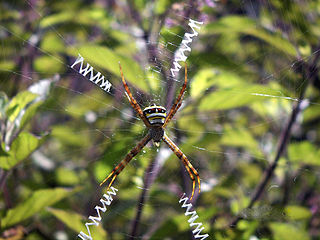
Argiope anasuja, is a species of harmless orb-weaver spider found from the Seychelles to India, Pakistan and Sri Lanka, and in the Maldives.
Hysterocrates gigas is a member of the tarantula family, Theraphosidae found in Cameroon. It is known as the giant baboon spider, Cameroon red baboon spider, or red baboon tarantula.
This glossary describes the terms used in formal descriptions of spiders; where applicable these terms are used in describing other arachnids.

Ero aphana is a species of pirate spider in the family Mimetidae. It is a hunting spider and feeds on other spiders.
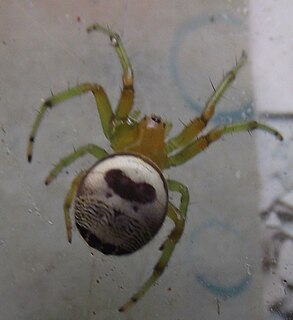
Araneus mitificus, commonly known as the kidney garden spider or pale orb weaver, is a species of orb-weaver spider found in South, East, and Southeast Asia.

Progradungula otwayensis, commonly known as the odd-clawed spider, is a species of cribellate spider endemic to the Great Otway National Park of Victoria, Australia. It is one of only two species in the gradungulid genus Progradungula.

Poecilotheria fasciata, or the Sri Lanka ornamental, is a large arboreal tarantula. It is endemic to central Sri Lanka.
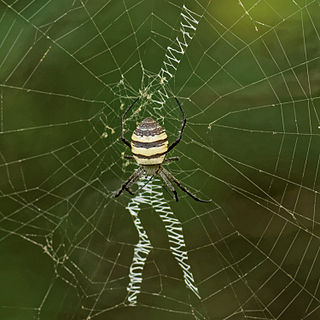
Argiope aemula, commonly known as the oval St Andrew's cross spider, is a species of spider in the family Araneidae which is native to southeast Asia, ranging from India and Sri Lanka to the Philippines, Indonesia, and Vanuatu. It is one of the giant, conspicuous "signature spider" species of the genus Argiope, observed in tropical and subtropical grasslands.

Heliophanus cupreus, the copper sun jumper, is a species of jumping spider belonging to the family Salticidae.

Archaea is an extinct genus of spiders in the family Archaeidae. As of October 2016, four species are placed in the genus. All have been found preserved in amber, either from the Baltic or Bitterfeld, Germany. First described in 1854, Archaea species have a distinctive "neck" separating the head from the thorax, and very long chelicerae ("jaws").
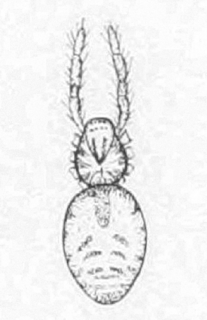
Dorymetaecus is a monotypic genus of Australian araneomorph spiders in the family Phrurolithidae, containing the single species, Dorymetaecus spinnipes. It was first described by William Joseph Rainbow in 1920, and has only been found on Lord Howe Island. Rainbow died in November 1919, shortly before publication of the work this species is described in.
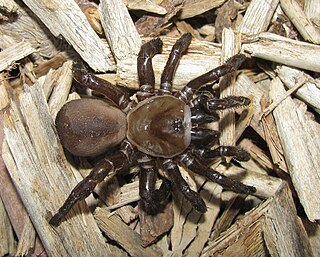
Halonoproctidae is a family of mygalomorph spiders, split off from the family Ctenizidae in 2018. Species in the family are widely distributed in North and Central America, Australasia, Asia, southern Europe and North Africa. One species is recorded from Venezuela in South America. They are relatively large, sombrely coloured spiders, that live in burrows with some kind of trapdoor.
Exechocentrus lancearius is a species of spider in the orb-weaver spider family Araneidae, found only in Madagascar. It was initially described from a partial specimen of an adult female. The first description of a complete specimen and its prey-catching behaviour was published in 2012. E. lancearius is a bolas spider. Rather than using a web, adult females catch their prey by using a line with one or two sticky drops which they swing.













